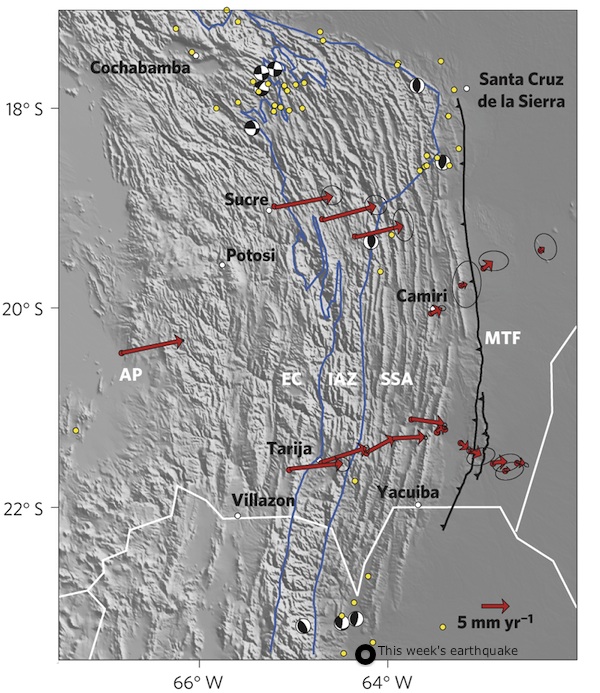![]() Yesterday a magnitude 6.2 earthquake struck in the Jujuy province of northwestern Argentina, in the western foothills of the Andes. What few news reports there are indicate strong shaking but little damage in what seems to be a remote and sparsely populated corner of South America.
Yesterday a magnitude 6.2 earthquake struck in the Jujuy province of northwestern Argentina, in the western foothills of the Andes. What few news reports there are indicate strong shaking but little damage in what seems to be a remote and sparsely populated corner of South America.
The focal mechanism for this shallow (5-10 km deep) earthquake indicates a fairly steeply dipping, north-south oriented thrust fault (guide for interpreting focal mechanisms).

View looking NW across South America towards the Andes, showing the location and focal mechanism of the M6.2 earthquake on October 6th. Other yellow dots are other earthquakes in this area in the past 7 days. Source: Google Earth/USGS
Given its location on the edge of a mountain range, this is not a surprise. Mountains are produced when two bits of crust are being pushed together: as more and more material gets squashed into the same area, the crust gets thicker, and the mountains rise. All of this squashing together is accommodated by a combination of folding and movement along thrust faults. The ultimate source of the convergence that is building the Andes is the Chilean subduction zone, where the Nazca plate is being subducted west beneath the west coast of South America. Much of the shortening at this boundary is accommodated on the subduction megathrust, which can generate very large earthquakes, but not all of it is. Between earthquakes, the subduction zone is locked, so convergence gets pushed into the over-riding South American plate, building up elastic strain. Most of this strain is released when the subduction zone finally ruptures again, but not all of it is: some of it will instead cause deformation and movement on faults behind the subduction zone. The fact that the Andes are there at all tells us that over millions of years, a reasonable fraction of the convergence between the South American and Nazaca plates was taken up in this way by deformation east of the plate boundary.
What’s interesting in this case is the location of the thrusting. Given where the subduction zone is, you might expect most of the major thrust faults to be on the western side of the Andes, closer to the plate boundary. Instead, if this earthquake is anything to go by, there is at least one significant thrust all the way over the mountains. And the indications are that it is not alone. GPS data from a paper published earlier in the year in Nature Geoscience shows that the whole length of the Andes in southern Bolivia, to the north of this week’s earthquake, is moving east relative to South America at a sizeable fraction of the Nazca Plate’s velocity, slowing only towards the eastern edge of the range. This implies that the whole mountain range might be being thrust as a single, fairly rigid block over the South American crust to the east.

Eastward motion of the Bolivian Andes relative to the rest of South America. Velocities only fall off towards the eastern edge of the range, where the Mandeyapecua thrust (MTF) is located. The black circle marks the approximate location of this week's earthquake. Source; Brooks <i>et al.</i>, Fig. 1.
As the figure above shows, the eastern Andes in the section studied in the paper by Brooks et al. is bounded by the 500 km-long Mandeyapecua Thrust Fault (MTF), which might be accommodating most of the sudden decceleration. If this fault ruptured along its entire length, it could possibly produce an earthquake as powerful as magnitude 8.9. Although this week’s earthquake was fairly small fry compared to that, it was probably on similar class of structure to the Mandeyapecua Fault – either a smaller thrust, or a small section of a larger thrust – and is the result of the same tectonic forces.



Comments (1)